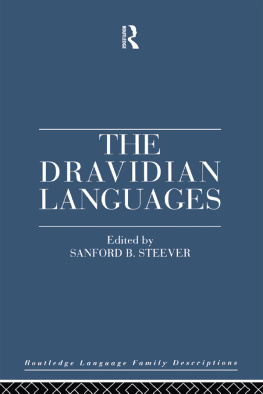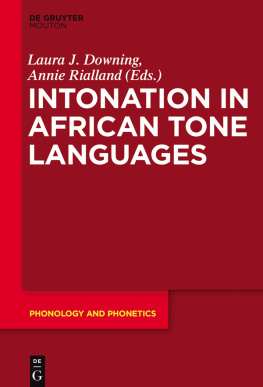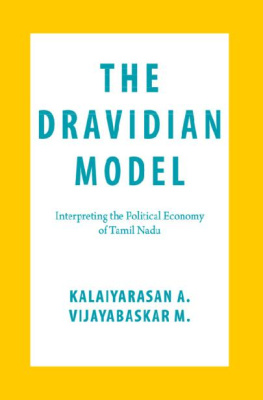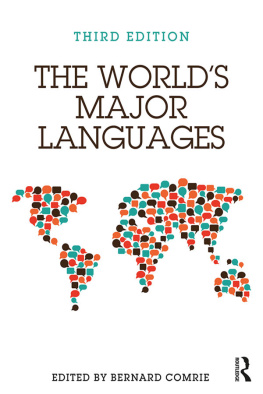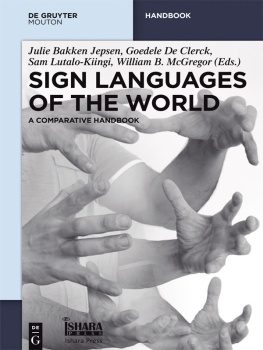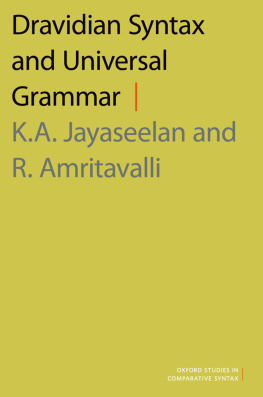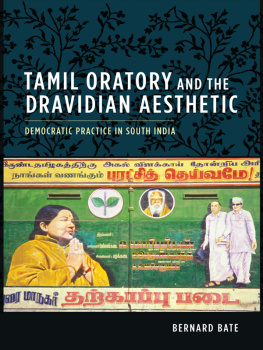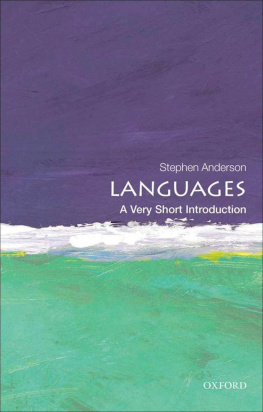Steever - The Dravidian Languages
Here you can read online Steever - The Dravidian Languages full text of the book (entire story) in english for free. Download pdf and epub, get meaning, cover and reviews about this ebook. City: London, year: 2006, publisher: Taylor and Francis;Routledge, genre: Home and family. Description of the work, (preface) as well as reviews are available. Best literature library LitArk.com created for fans of good reading and offers a wide selection of genres:
Romance novel
Science fiction
Adventure
Detective
Science
History
Home and family
Prose
Art
Politics
Computer
Non-fiction
Religion
Business
Children
Humor
Choose a favorite category and find really read worthwhile books. Enjoy immersion in the world of imagination, feel the emotions of the characters or learn something new for yourself, make an fascinating discovery.
- Book:The Dravidian Languages
- Author:
- Publisher:Taylor and Francis;Routledge
- Genre:
- Year:2006
- City:London
- Rating:4 / 5
- Favourites:Add to favourites
- Your mark:
- 80
- 1
- 2
- 3
- 4
- 5
The Dravidian Languages: summary, description and annotation
We offer to read an annotation, description, summary or preface (depends on what the author of the book "The Dravidian Languages" wrote himself). If you haven't found the necessary information about the book — write in the comments, we will try to find it.
The Dravidian Languages — read online for free the complete book (whole text) full work
Below is the text of the book, divided by pages. System saving the place of the last page read, allows you to conveniently read the book "The Dravidian Languages" online for free, without having to search again every time where you left off. Put a bookmark, and you can go to the page where you finished reading at any time.
Font size:
Interval:
Bookmark:
THE DRAVIDIAN
LANGUAGES
Other works in the series
The Romance Languages
The Celtic Languages
The Slavonic Languages
The Germanic Languages
The Indo-European Languages
The Semitic Languages
Forthcoming works in the series
The Uralic Languages
The Turkic Languages
THE
DRAVIDIAN
LANGUAGES
EDITED BY
Sanford B. Steever

First published 1998
by Routledge
11 New Fetter Lane, London EC4P 4EE
29 West 35th Street, New York, NY 10001
1998 Routledge
1998 Editorial matter Sanford B. Steever
Typeset in 10/12 Ecological Linguistics DravidianTranslit by Peter T. Daniels
All rights reserved. No part of this book may be reprinted or reproduced or utilized in any form or by any electronic, mechanical, or other means, now known or hereafter invented, including photocopying and recording, or in any information storage or retrieval system, without permission in writing from the publishers.
British Library Cataloguing in Publication Data
A catalogue record for this book is available from the British Library
Library of Congress Cataloging-in-Publication Data
The Dravidian languages / edited by Sanford B. Steever.
p. cm. (Routledge language family descriptions)
Includes bibliographical references and index.
(HB: alk. paper)
1. Dravidian languages. I. Steever, Sanford B. II. Series.
| PL4601.D73 | 1997 |
494dc21 | CIP |
ISBN 0-415-10023-2
Sanford B. Steever
William Bright
Thomas Lehmann
E. Annamalai and S. B. Steever
Sanford B. Steever
D. N. S. Bhat
P. Ramanarasimham
Bh. Krishnamurti
Bh. Krishnamurti and Brett A. Benham
Sanford B. Steever
P. S. Subrahmanyam
Peri Bhaskararao
Sanford B. Steever
Josef Elfenbein
E. Annamalai, Director of the Central Institute of Indian Languages, Mysore, India.
Brett A. Benham, University of Texas at Arlington, Texas, USA. Peri Bhaskararao, Japan.
D.N.S. Bhat, Mysore, India.
William Bright, University of Colorado, Boulder, Colorado, USA.
Josef Elfenbein, University of Mainz, Germany.
Bh. Krishnamurti, University of Hyderabad, Hyderabad, India.
Thomas Lehmann, South Asia Institute, University of Heidelberg, Germany.
P. Ramanarasimham, University of Hyderabad, Hyderabad, India.
Sanford B. Steever, Dravidian Linguistics Association and Linguistic Society of America.
P.S. Subrahmanyam, Annamalai University, India.
The Dravidian Languages owes its existence to another book: it grew out of a chapter on the Dravidian language family written for The Worlds Major Languages a decade ago. At that time, when theoretical work commanded the attention and resources of most linguists, The Worlds Major Languages answered a call to provide both general readers and professional linguists with accessible, concrete descriptions of various languages around the world. That volume and the mandate underlying it came to serve as the basis for Routledges language reference series, of which The Dravidian Languages is the most recent instalment.
Handbooks of the Dravidian language family have appeared over the past 150 years, but virtually all of them are comparative studies geared towards the needs of specialists in historical and typological linguistics. These studies tend to juxtapose individual forms from one language to the next; in doing so, they have often lost sight of the grammatical systems in which those forms originally appeared. None of them provides self-contained descriptions of the individual Dravidian languages, their speakers, their structure and their historical development. This state of affairs reflects, in part, the fact that grammars and even raw data for the Dravidian languages are generally hard to come by, taxing the ingenuity of the most dedicated specialist. So it comes as no surprise that nothing to date has appeared in print to which the layman or linguist might turn to satisfy his curiosity about these individual languages. The Dravidian Languages attempts to fill in that gap in our knowledge of this language family.
The present volume contains readable descriptions of 12 of the individual languages written by internationally recognised experts. Each chapter introduces the reader to the language and its speakers, then proceeds to discuss its internal structure in sections devoted to phonology, morphology and the parts of speech, syntax and lexicon. The Dravidian Languages also serves the needs of historical linguistics: its design invites comparison among the various chapters. The contributors have been encouraged to depart from the general format where it would distort or diminish the prominence of a salient aspect of the language under description. A general introduction to the family and to the Dravidian writing systems round out the book.
The biggest editorial challenge in designing and preparing this volume lay in the selection of languages. There are simply too many Dravidian languages to fit into a single volume: at least 23 modern languages plus three ancient ones. Furthermore, what we know about the Dravidian languages varies greatly in depth and quality from one language to the next. Just four of the languages have a substantial writing tradition, and can provide linguistic examples from before the modern era. At the other end of the spectrum, some languages are barely attested; Naiki, for example, is known primarily from word-lists. While Gadaba has been described in two grammars, only two texts totalling 450 sentences have ever appeared in print. No major publication has appeared on Ki since the Reverend Winfield brought out his grammar in 1928. Examples may be all too easily multiplied. Some of the grammars of these languages are long out of print, some lie collecting dust in rarely visited libraries and others still exist only in manuscript form. Particularly where several of the non-literary languages are concerned and where the need for research is greatest, we lack scholars with an intimate knowledge of the language actively pursuing its study. Since this volume, as others in the language reference series, relies on the informed contributions of individual experts, some languages had to be passed over which I would otherwise have wished to include.
Given these conditions, I chose to offer as broad a selection as I could. At least two languages were chosen from each of the four major subgroups: this breadth is useful both for comparative purposes and to display the range of variation among the different languages of the family. The languages of the southern and south-central branches of the family, which include all of the literary languages of the Dravidian family, have been accorded a broader representation, with four languages each. Although each language omitted from this volume is an occasion for regret, languages from two areas are sorely missed. I would have liked to have included a chapter on the languages spoken on the Nilgiris Massif, Toda, Kota, Baaga and Irula, as well as one on the languages spoken in the Khondmal Hills of Orissa, Ki, Kvi, Pengo and Mana. Besides the intrinsic linguistic and anthropological interest of these languages, several are faced with extinction in the near term as their speech communities are dispersed and their speakers assimilated into the surrounding dominant regional languages. To appreciate the true
Next pageFont size:
Interval:
Bookmark:
Similar books «The Dravidian Languages»
Look at similar books to The Dravidian Languages. We have selected literature similar in name and meaning in the hope of providing readers with more options to find new, interesting, not yet read works.
Discussion, reviews of the book The Dravidian Languages and just readers' own opinions. Leave your comments, write what you think about the work, its meaning or the main characters. Specify what exactly you liked and what you didn't like, and why you think so.

